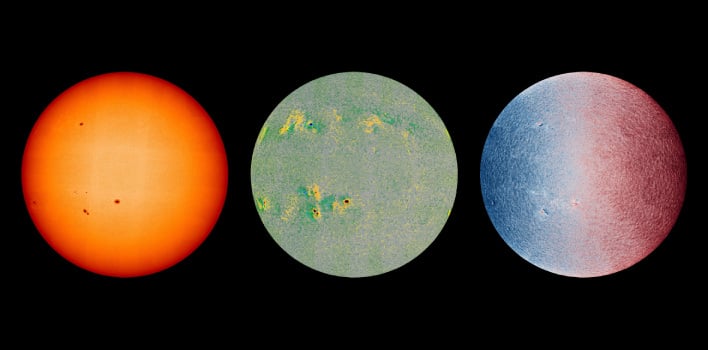Solar Orbiter Snaps Highest-Ever Resolution Shots Of The Sun To Reveal Amazing Details
The observations used to stitch together the new high-resolution images were captured around the same time the ESA’s Solar Orbiter and NASA’s Parker Solar Probe were performing incredibly hot spacecraft gymnastics to help solve a cosmic mystery about the Sun in March of last year. The latest release follows up on one from two years ago, when the mission released full images of the Sun taken by the spacecraft’s EUI and Spectral Imaging of the Coronal Environment (SPICE) instruments on March 7, 2022.
"The Sun's magnetic field is key to understanding the dynamic nature of our home star from the smallest to the largest scales,” remarked Daniel Müller, Solar Orbiter's Project Scientist. “These new high-resolution maps from Solar Orbiter's PHI instrument show the beauty of the Sun's surface magnetic field and flows in great detail. At the same time, they are crucial for inferring the magnetic field in the Sun's hot corona, which our EUI instrument is imaging.”
In total, the Solar Orbiter has six imaging instruments. The newest images were in part made by the spacecraft’s Polarimetric and Helioseismic Imager (PHI)j. The ESA says this instrument not only takes images in visible light, but also measures the direction of the magnetic field, and maps how quickly and in what direction parts of the Sun’s surface are moving.
PHI’s measurements of the photosphere were then compared to an image of the Sun’s outer atmosphere (the corona) assembled from high-resolution images captured by the Extreme Ultraviolet Imager (EUI) instrument.
According to the ESA, one of the “most striking features” in the images are the sunspots. In the visible light image (seen at top of article), these appear as dark spots, or holes. The ESA says sunspots are colder than their surroundings, and therefore give off less light, hence the dark coloring.
All of the images were taken while the Solar Orbiter was less than 74 million kilometers from the Sun. With the close proximity, it meant each high-resolution image taken by the two instruments only covered a small portion of the Sun. Following each individual image taken, the spacecraft needed to be tilted and rotated until each part of the Sun’s surface was captured.
This also meant that the full-disc images had to be stitched together like a mosaic. The PHI and EUI mosaics are composed of 25 images each, taken over a period of about four hours. The Sun’s disc has a diameter of about 8000 pixels in the full mosaic, meaning there is a lot of detail in it.
With the first imaging process required to obtain the PHI mosaics complete, the ESA hopes to be able to produce similar high-resolution images of the Sun twice a year. Full scale renders of the images can be viewed on the European Space Agency’s website.



